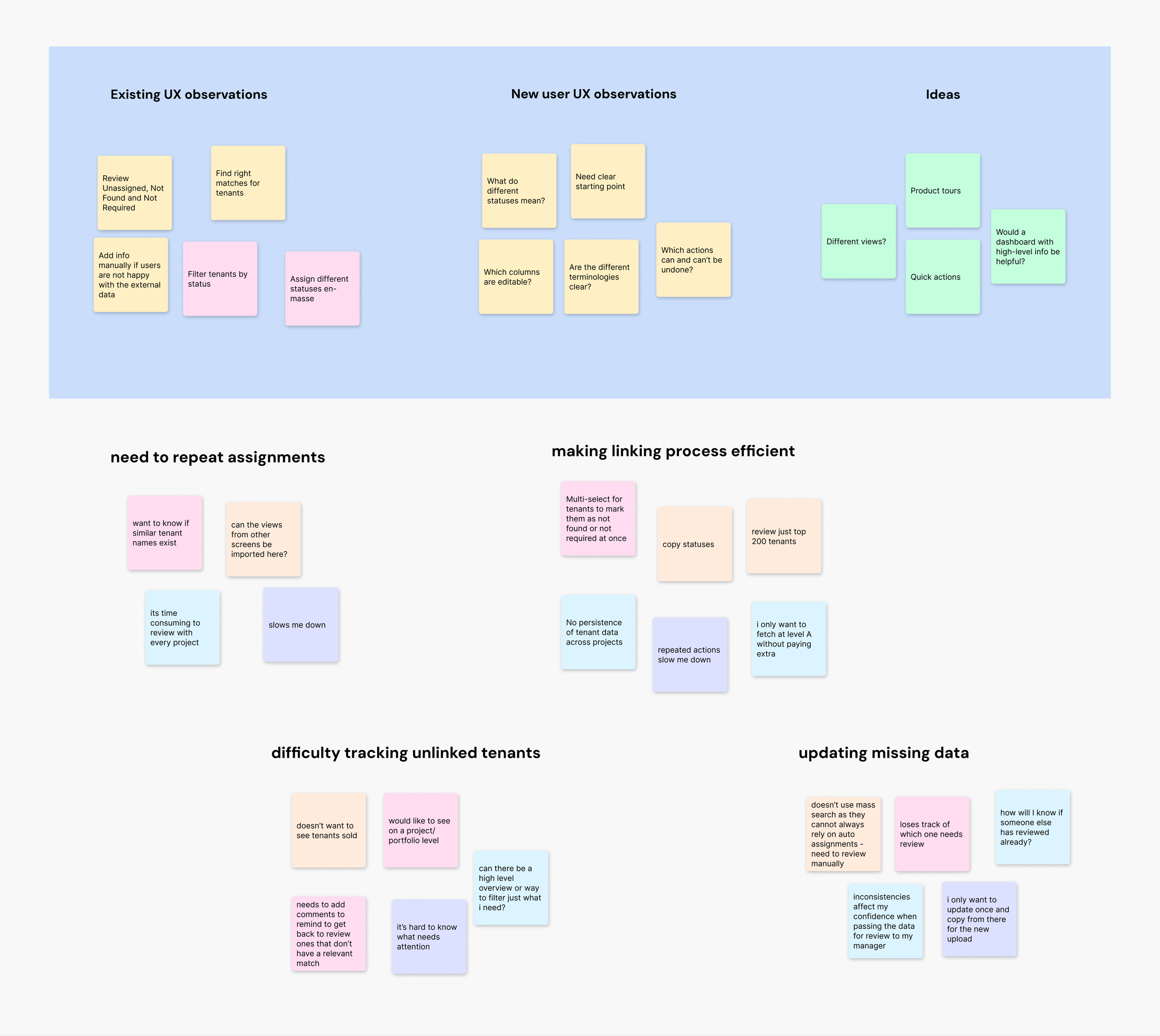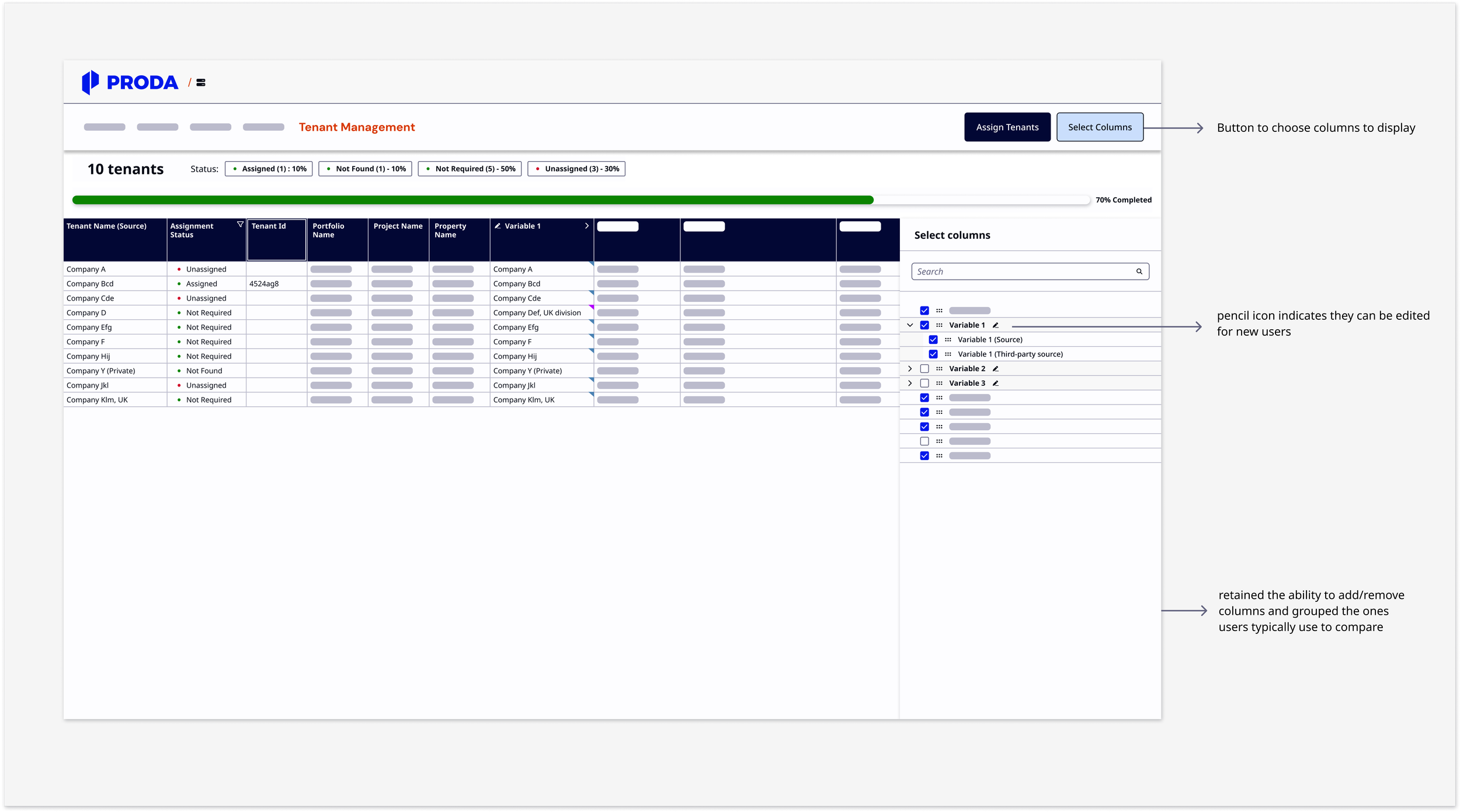From Repetition to Retention: Redesigning Tenant Management for Scale
Role: User Experience Designer with 1 Product Manager and 2 developers
Skills: User research, Product Discovery, Wireframe and Prototype, UX/UI, Miro, Figma, Collaboration, AGILE
Timeline: July - November 2024
Please note: The work done is copyrighted under PRODA Ltd. IP hence, I’m not at liberty to share all details. Certain visual assets used serve as representations of the process.
Summary
At PRODA, tenant management is central to how enterprise clients assess portfolio risk. A recurring issue came up in feedback: every time clients uploaded Rent Rolls, they had to redo tenant assignments from scratch. This repetitive process frustrated users, especially high-value enterprise clients, and posed churn risk.
I was tasked with leading end-to-end design on this initiative. Through discovery sessions with users and close collaboration with PMs on the product roadmap, I identified the core friction points, developed user flows, and iterated on solutions with developers based on feedback. This enabled the creation of a centralized tenant management system that persisted tenant data across projects and enriched profiles via third-party insights.
Impact
15% ↑
user satisfaction
Clear visual indicators helped track and manage assignments efficiently
10% ↑
user retention
Easy third-party data access enabled better risk analysis and also boosted upselling opportunities
60%
adoption
Successfully met the Q4 goal of adoption by existing customers
Research & Ideation
User Research, User flow, Persona, Wireframes, Prototype, Usability Testing, Problem-solving
I conducted qualitative research using 1:1 interviews and focus groups for deeper discovery and to validate business-identified pain points by uncovering how they impacted user workflows and expectations.

Product planning to identify edge cases, determine happy path and understanding what would give users most value.

Analysing customer feedback into themes for identifying design interventions opportunities.
Personas
From this research, I identified two key personas: Asset Managers, who handle tenant assignments and review data at a granular level, and Admins, who oversee assignments at scale to support strategic planning. These personas helped prioritize smaller features and shape the overall functionality, directly informing the product roadmap.

“I'd like to link the tenants efficiently and manage them on project level to save time”

“I would like to identify and review missing tenant related information on a high level and update it just once”
User flow
Based on persona needs I defined a user flow, which was agreed upon by PMs and developers, focused on two core actions:
1. linking tenants to a third-party database and importing linked data
2. reviewing and editing imported data against the original source
I decided to validate this flow by testing early design ideas that introduce clearer journeys to link, compare and edit data. The goal was to understand whether these changes addressed key pain points - if users found the flow intuitive, felt more in control, and use the feedback to inform our next design direction.
Core Insight
Initial research validated the issue but revealed a deeper insight: users weren’t just overwhelmed by repetition, but also wanted clear visibility to track their progress.
I co-facilitated discovery sessions with Product to clarify edge cases and involved developers early to understand technical limitations and uncovered that some of our initial design ideas, like multi-view navigation, would significantly delay delivery. I re-evaluated the plan and shifted to a simplified sidebar, retaining core features of existing UI grid framework used while adding progress bars and status indicators for clarity.
This approach prioritized simplicity and clarity balancing with delivery speed, enabling a faster launch and gathering feedback to inform a stronger V2, which was essential from a business perspective.
Solution
User Interface Design, Prototypes and Testing, Dev-handover, Analytics
The final solution was a redesigned interface built with repurposed components making it both scalable and fast to develop. I introduced visual tracking (progress bars, badges), simplified decision-making (clear data selection), and worked within our design system to keep the experience consistent and accessible.
To validate direction, I tested interactive prototypes with users and iterated based on their feedback. We knew we were on the right track when users completed tasks quickly, engaged with new features, and shared positive feedback. Despite time constraints and scope trade-offs, the design delivered on its core promise: fewer repetitive actions, easy tracking, and a smoother workflow. Within the first quarter, the new feature met 60% adoption, reducing churn risk and creating opportunities for upsell.


Interactions
1. Progress Tracking
To motivate users and encourage 100% tenant management, I introduced a real-time progress bar and color-coded status badges, leveraging behavioral principles like the Zeigarnik and Goal-Gradient effects. These elements increase task visibility, nudging users towards completion and offer quick insight into assignment progress.
2. Flexible Entity Selection for Data Fetching
To support a pay-per-fetch model, I designed a multi-select dropdown with checkboxes, allowing users to choose which entity to fetch data for. It balances current needs building trust in the system with future scalability to accommodate more entities.
3. Clear Comparison for Data Review
Tenant names were presented in a unified column that shows third-party data by default, with the option to compare against Rent Roll input. Users can override data as needed, indicated by a pencil icon and a purple flag for manual edits, with changes synced across projects for consistency.
Vision for the future
Looking ahead, I will collaborate with Product to focus on better performance for handling large datasets and exploring presets to improve efficieny. In the coming months, we aim to gather customer feedback from new Rent Roll uploads and track user sessions via Userpilot to understand how users customize views. Key metrics include % of tenants managed per project, assignment completion journeys, and time to complete tasks. This next phase is guided by real usage data, allowing us to iterate intentionally.


